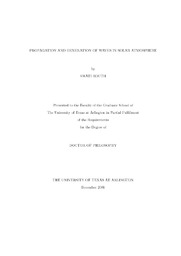
ATTENTION: The works hosted here are being migrated to a new repository that will consolidate resources, improve discoverability, and better show UTA's research impact on the global community. We will update authors as the migration progresses. Please see MavMatrix for more information.
Show simple item record
| dc.contributor.author | Routh, Swati | en_US |
| dc.date.accessioned | 2010-03-03T23:30:53Z | |
| dc.date.available | 2010-03-03T23:30:53Z | |
| dc.date.issued | 2010-03-03T23:30:53Z | |
| dc.date.submitted | January 2009 | en_US |
| dc.identifier.other | DISS-10558 | en_US |
| dc.identifier.uri | http://hdl.handle.net/10106/2103 | |
| dc.description.abstract | The fact that the temperature increases with height in the solar atmosphere has been known for many years. To maintain this temperature increase, sources of heating must be present in the atmosphere. One of the most important, and still unsolved, problems in solar physics is to identify the basic physical processes that are responsible for this heating, and explain solar activities caused by the heating. It is also observationally well-established that the solar atmosphere shows a broad range of oscillations that are different in magnetic and non-magnetic regions of the atmosphere.The oscillations are driven by propagating waves, which cause the atmosphere to oscillate at its natural (cutoff) frequency. Since different waves have different cutoff frequencies, it is important to have a method that would allow determining such cutoffs for the solar atmosphere.In this PhD dissertation, the concept of cutoff frequency is extended to inhomogeneous atmospheres, and a general method to determine the cutoff frequency is presented. The method leads to new forms of wave equations obtained for all wave variables, and allows deriving the cutoff frequency without formally solving the waveequations. The main result is that the derived cutoff frequency is a local quantity and that its value at a given atmospheric height determines the frequency that waves must have in order to be propagating at this height. The developed method is generalenough, so that it can be used to establish theoretical bases for studying the propagation and generation of different waves in the solar atmosphere. Acoustic waves play an important role in the heating of magnetic-free regions of the solar atmosphere. To determine the propagation conditions for these waves in thenon-isothermal solar atmosphere, the method is used to obtain the resulting acoustic cutoff frequency. This new cutoff frequency is a local quantity and it generalizes Lamb's acoustic cutoff frequency that was obtained for an isothermal atmosphere.The method is also used to extend Lighthill's theory of sound generated by turbulent motions, which was originally developed for a uniform medium, to the case when the background medium has a special temperature distribution. Basic equations describing the efficiency of the acoustic wave generation are derived and specific results are presented.Magnetic regions of the solar atmosphere, identified here with magnetic flux tubes, are heated by longitudinal, transverse and torsional waves. If the tubes are isothermal, then the propagation of longitudinal and transverse tube waves is restricted to frequencies that are higher than the corresponding cutoff frequency foreach wave. However, no such cutoff frequency exists for torsional tube waves. The results obtained in this PhD dissertation demonstrate that temperature gradients andother inhomogeneities of solar magnetic flux tubes lead to a significant modification of the cutoff frequency for transverse tube waves and to the origin of a new cutoff frequency for torsional tube waves. This new cutoff is used to determine conditionsfor the wave propagation in the solar atmosphere, and the obtained results are compared to the recent observational data that support the existence of torsional tube waves on the Sun. | en_US |
| dc.description.sponsorship | Musielak, Zdzislaw | en_US |
| dc.language.iso | EN | en_US |
| dc.publisher | Physics | en_US |
| dc.title | Propagation And Generation Of Waves In Solar Atmosphere | en_US |
| dc.type | Ph.D. | en_US |
| dc.contributor.committeeChair | Musielak, Zdzislaw | en_US |
| dc.degree.department | Physics | en_US |
| dc.degree.discipline | Physics | en_US |
| dc.degree.grantor | University of Texas at Arlington | en_US |
| dc.degree.level | doctoral | en_US |
| dc.degree.name | Ph.D. | en_US |
| dc.identifier.externalLink | https://www.uta.edu/ra/real/editprofile.php?onlyview=1&pid=114 | |
| dc.identifier.externalLinkDescription | Link to Research Profiles | |
Files in this item
- Name:
- Routh_uta_2502D_10558.pdf
- Size:
- 1.042Mb
- Format:
- PDF
This item appears in the following Collection(s)
Show simple item record


